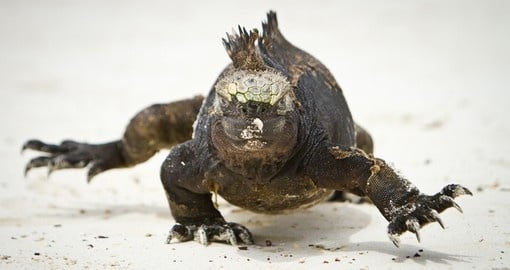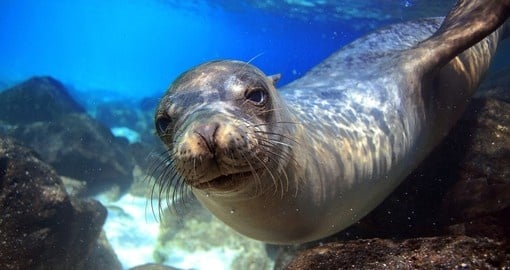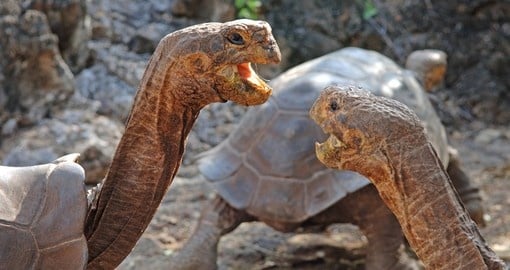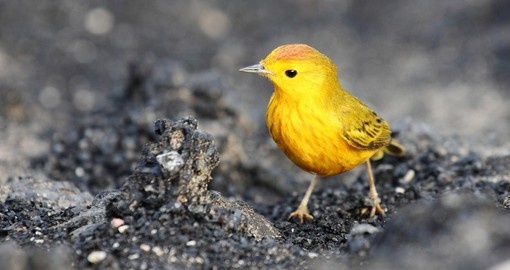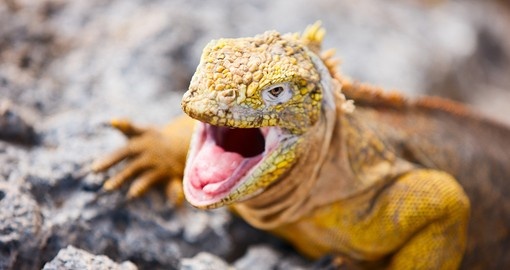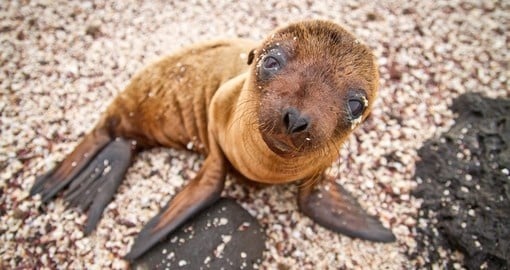Galapagos Nature Calendar
Click here for General information on Galapagos.
Located to the west of continental Ecuador, the Galápagos Islands are an archipelago of volcanic islands on either side of the Equator in the Pacific Ocean. The islands are also a national park and marine reserve.
In 1978 the area was named a UNESCO World Heritage Site and in 1985 it became a biosphere reserve. The islands are an ecological wonderland populated with fearless and incredible wildlife. The largest living tortoise species, the Galápagos Tortoise is famous for its long lifespan and can weigh over 400 kg (880 lbs). The distinctive blue-footed booby is synonymous with the islands, and so too are the colonies of curious sea lions. Besides unique wildlife, there are also excellent beaches that welcome swimming, diving and surfing. A visit to the Galápagos Islands is a truly spectacular experience that continues to attract tourists from around the world.
The following "nature" calendar of the Galapagos may help you decide when you want to travel.
Download the calendar in PDF format.
January
- Beginning of the rainy season.
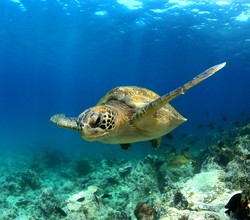
- Land birds start nesting, generally after the first rain.
- On Hood Island adult marine iguanas become brightly colored (green, red + black).
- The green sea turtles arrive at beaches in the Galapagos for egg laying period.
- Land iguanas begin reproductive cycles on Isabela Island.
- Both, water and air temperatures rise and stay warm until June.
- The ideal time for snorkeling.
February
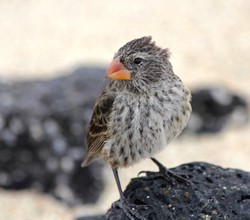
- On Floreana Island greater Flamingos start nesting.
- Bahama Pintail ducks (Black-tailed Pintail) start their breeding season.
- Nazca (masked) Boobies on the hood are at the end of their nesting season.
- Marine iguanas nest on Santa Cruz Island.
- The highest water temperature reaches 25c (77f). This temperature remains constant until April.
- Very few penguins are sighted at Bartolome Island (most have followed the cool waters back to the west or near Upwelling areas).
- Nesting season of the Galapagos Dove reaches its peak.
March
- The rainy season reaches the highest precipitation
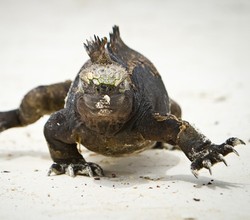 .(this does not mean it rains everyday)
.(this does not mean it rains everyday) - Sporadic tropical rains, intense sun and hot climate. Air temperature can reach up to 30c (86f). Humidity is high.
- Marine iguanas nest on Fernandina.
- March 21st, the beginning of the summer equinox signals the arrival of the waved albatross to Espaola.
- Even the western islands have warm waters where snorkeling is excellent. Punta Vicente Roca Isabela can be an amazing site.
- Penguins are still active in the water, next to tropical fish! (how Bizarre!).
- Some shores, especially those facing the north side, can receive deep surge (Ola de Fondo) Proveniente de Las Corrientes del Norte.
- Snorkelers will remain long periods of time in the water.
April
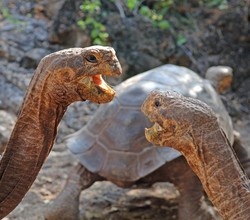
- Massive arrival of waved albatrosses to Espanol. Amazing courtship starts.
- End of the hatching season of the giant tortoises.
- Eggs of green sea turtles begin to hatch.
- Eggs of land iguanas hatch on Isabela.
- While the rains have ended, the islands quite continue green.
- Good visibility in the water for snorkelers.
- Perhaps, together with May, the best month in Galapagos
- (weather, animals, water temperature).
May
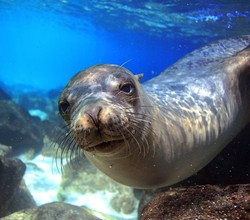 North Seymour’s Blue-footed Boobies Begin their courtship
North Seymour’s Blue-footed Boobies Begin their courtship- Sea turtles are still hatching on GardnerBay, Punta Cormorant, and Puerto Egas.
- Most of marine iguanas’ eggs hatch from nests on Santa Cruz
- Palo Santo trees gegin to shed their foliage
- Waved Albatross on Espaola start laying their eggs
- Ban-Rumped storm Petrels begin their first nesting Period.
June
- Beginning of the Garacute season.
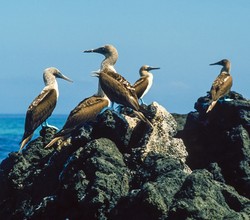
- Giant tortoises on Santa Cruz Island migrate from the highlands to the lowlands in search of suitable nesting places.
- Beginning of the nesting season of giant tortoises.
- South east trade winds return. Currents become a bit stronger. Seas pick up in surge and wave action.
- Many Red Pouches by males of magnificent Frigatebirds on North Seymour.
- Southern migrants have started their journey towards the north. Galapagos is a rest stop for such Birds.
- Some species of cetaceans also follow this pattern of migration.
- Some groups of humpback whales that migrate up to equatorial latitudes along the coast of Ecuador, can reach the Galapagos too.
July
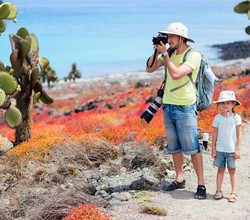 Sea bird communities are very active (breeding), especially the Blue Footed Boobies on Espaola.
Sea bird communities are very active (breeding), especially the Blue Footed Boobies on Espaola.- Flightless cormorants perform beautiful courtship rituals and nesting activities on Fernandina.
- If you walk along the shores of PuertoEgasSantiagoIsland you could find american oyster catchers nesting.
- Lava Lizards initiate mating rituals until November.
- Cetaceans (whales; dolphins) are more likely to be observed, especially off the western coast of Isabela.
- Great month to see the four stages of nesting in Blue Footed Boobies: eggs, chicks, juveniles and subadults.
- Water temperature does not reach more than 21c (68f).
August
- Galapagos hawks court Espaola and Santiago.
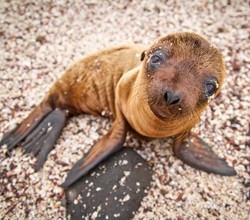
- Nazca (masked) boobies and Swallow-tailed gulls nest on Genovesa Island.
- The temperature of the ocean drops to 18C (64F), which obviously varies according to the geographic zones among the islands.
- Migrant shore birds start to arrive, and stay on the islands until March.
- Giant tortoises return to the highlands of Santa Cruz Island.
- Oceans are quite choppy, currents at the strongest levels, surge can be expected along the shores that face west or south.
- Pupping season (births) of sea lions has started. Western and central islands are common places for such sightings.
September
- Peak of the cold (garúa) season.
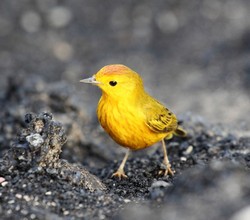
- The air temperature reaches its lowest levels (19C-66F).
- Galapagos Penguins show remarkable activity on Bartolome.
- Since May swimmers and snorkelers can be delighted at Bartolome with penguins active at the surface or torpedo-like while underwater.
- Sea lions are very active. Females have reached estrus stage, and so harem-gathering males are constantly barking and fighting.
- Shore fighting is heavy. Western and central islands are the most active ones in terms of sea lions’ activities.
- Most species of sea birds remain quite active at their nesting sites.
October
- Lava herons start nesting until March
- The Galapagos Fur Sea lions begin their mating period
- Blue footed boobies raise chicks all over Espaola and Punta Vicente Roca Isabela
- Giant tortoises are still laying eggs
- Days are not always sunny. Garcute can be expected in most locations, except the western islands where most days have a misty start but after few hours of daylight it burns off.
- Sunrises in the west can be quite beautiful after the garua covers only certain locations of the western volcanoes.
- Summits are clear, but low-lying fog covers the shoreline.
November
- Pupping of sea lions continues.
- Sea lions are sexually active in the eastern part of the archipelago. Breeding season for the brown noddies.
- Some species of jellyfish can be seen around the islands.
- The genus Physalia is commonly seen floating around Gardner and Tortuga Islets.
- Some can also be seen stranded at the shores of the Flour Beach at Florena.
- Band-rumped storm petrels begin their second nesting period.
- The seas are calm. Southeast trade winds have decreased strength. Water temperatures are slowly rising.
- Generally, great weather is due to a transition between one season and the next.
- Good visibility for snorkelers. Sea lion pups (especially at Champion Islet) play aqua aerobics next to snorkelers.
- Most pups here are curious enough to nibble at the fins of snorkelers. The average age of most pups is 3-4 months.
December
- Hatching of giant tortoise’s eggs begins and lasts until April
- Green sea turtles display their mating behaviour
- The rainy season begins, and all of the plants in the dry zone produce leaves. Galapagos becomes green
- The first young waved albatrosses fledge
- Great weather. Mostly sunny days. Hardly any wind from the southeast. Waters continue to warm up.
- Western islands remain very dry. Water temperature is still cool for long snorkeling periods.
- First red pouches of Great frigatebirds seen at Genovesa
- Nothern migrants have started their journey towards the south. Galapagos is a rest stop for these birds.
- Some species of Cetaceans also follow this pattern of migration.
Other Information:
Climate changes in Galapagos What makes the islands an outstanding destination? February is the most important month during the Hot Season. At this time of the year, the islands not only adopt an emerald-green color, and turn humid and balmy warm, but many species start reproducing now. For these, this time is the only one where they have their best chance to pass their genes to the next generation. Thus, February is a month when lots of unique and exciting things exclusively happen. The experience is quite unique for our guests, and no one should miss seeing this amazing realm. A couple of highlights include the Marine Iguanas (especially those in Punta Espinoza, Fernandina Island and Punta Suarez, Española Island) with eye-catching colors, and nesting behaviour. But of course, the most committed effort goes to the frigate birds. Males will display their scarlet-red gular pouches as they try to attract a passing female. Such wildlife encounters will continue until the end of April, but it is during February, March and April when the most rewarding natural events and wildlife encounters will occur.
The marine environment deserves special attention, since the warm waters stationed at the Panamic Province, are ready to head down south while bathing the Gal·pagos. We expect water temperatures to range between 24°C and 27°C (76°F and 80°F), and visibility to be generally good (15-18 metres; 50-60 feet). Having a marine tropical ecosystem next to penguins and sea lions (that come from much colder and temperate environments) is another enriching wildlife experience. What other tropical destination on Earth has a penguin? Of course, zoos donít count! The Galapagos Marine Reserve will delight every single explorer, particularly at the most western islands of the archipelago (Isabela & Fernandina). Snorkeling and glass-bottom boat outings are adventures you should not miss.
Ecuador Travel Information
At Goway we believe that a well-informed traveller is a safer traveller. With this in mind, we have compiled an easy-to-navigate travel information section dedicated to Ecuador.
Learn about the history and culture of Ecuador, the must-try food and drink, and what to pack in your suitcase. Read about Ecuador's nature and wildlife, weather and geography, along with 'Country Quickfacts' compiled by our travel experts. Our globetrotting tips, as well as our visa and health information will help ensure you're properly prepared for a safe and enjoyable trip. The only way you could possibly learn more is by embarking on your journey and discovering Ecuador for yourself. Start exploring… book one of our Ecuador tours today!
Extend Your Trip
After your Ecuador vacation packages, why not consider another of Goway's Latin America tours. These include a large selection of other exciting countries in Central and South America. We offer Chile vacation packages and Easter Island tours, Peru vacation packages which include Machu Picchu tours and Brazil tours including Iguassu Falls tours among many others.
Book your Ecuador tour with Goway!
 LATIN AMERICA by Goway is an exclusive division that specializes in planning and organizing Ecuador tours and experiences. Choose from a simple city stopover, a cruise to the Galapagos Islands, a Holiday of a Lifetime tour, a small group tour and much more. We want to be your first choice when next you go globetrotting to Ecuador.
LATIN AMERICA by Goway is an exclusive division that specializes in planning and organizing Ecuador tours and experiences. Choose from a simple city stopover, a cruise to the Galapagos Islands, a Holiday of a Lifetime tour, a small group tour and much more. We want to be your first choice when next you go globetrotting to Ecuador.
Get a Trip Quote Order a Brochure






